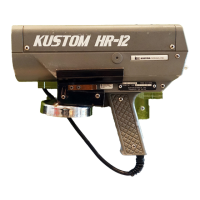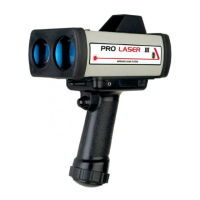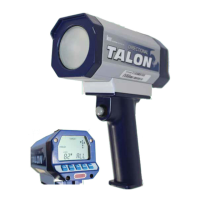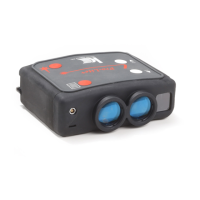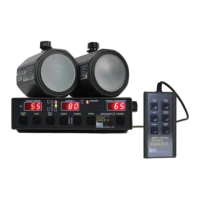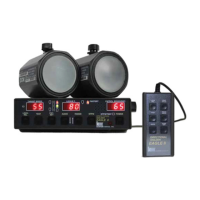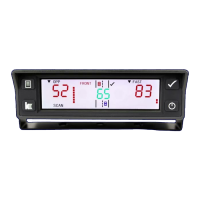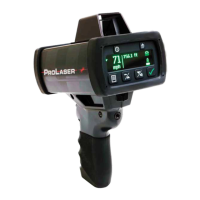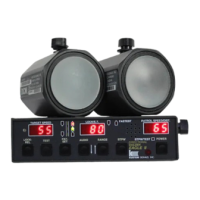Do you have a question about the Kustom Signals Falcon HR and is the answer not in the manual?
General specifications and operating voltage details for the FalconHR radar system.
Operational characteristics including speed processor, lock time, and display type.
Instructions for inspecting the unit and its packaging upon receipt.
Lists standard and optional equipment included with the radar system.
Details on connecting power and speedometer cables for operation.
Instructions for installing the auxiliary power receptacle.
Instructions for installing the speedometer pulse cable.
Procedures for mounting the radar unit and antenna in the vehicle.
Explains the side view of the FalconHR unit, including the trigger and connectors.
Identifies and describes the indicators and buttons on the rear panel of the unit.
Details the functions of the wireless and wired remote controls.
Describes the optional mounting pod and its ports.
Explains the basic principles of how the radar system operates.
Discusses safety and exposure levels related to microwave emissions.
Importance of tuning fork tests for accuracy and functionality.
Describes the power-on sequence and initial self-tests.
Explains the unit's automatic self-testing features during operation.
How to manually perform indicator and internal tests.
Procedures for simulating targets using tuning forks.
Steps to perform stationary tuning fork tests.
Steps for tuning fork tests in moving opposite mode.
Steps for tuning fork tests in moving same direction mode.
Troubleshooting steps for tuning fork test failures.
Process to synchronize the radar with the vehicle's speedometer.
How to set a minimum patrol speed threshold.
Verifying patrol speed readings against the vehicle's speedometer.
Lists and briefly describes the five operating modes of the radar system.
Covers setup for handheld and dash-mounted operations.
Instructions for charging the battery handle using standard and fast chargers.
How the unit monitors and indicates battery status.
Guidance on selecting optimal locations for stationary operation.
How to adjust the Doppler audio listening level.
Procedure to unsquelch and resquelch the audio output.
How to set and adjust the radar's detection range.
How to turn the unit's backlight on and off.
Specific operating procedures for handheld use.
Steps for setting up and performing a tracking history in handheld mode.
How to lock target speeds and the implications of the lock.
Operation of the fastest vehicle detection feature.
Specific operating procedures for dash-mounted use.
Steps for setting up a dash-mounted unit using the mounting pod.
Operating the unit in stationary modes (Approaching, Receding, All).
Procedures for operating in moving mode with opposing traffic.
How to use the HOLD function in moving mode.
Locking target speeds in moving mode.
Blanking the patrol speed display.
Using the fastest vehicle feature in moving mode.
Locking the fastest vehicle speed.
Procedures for operating in moving mode with same-direction traffic.
How the speedometer input affects operation.
How AMS switches between modes based on vehicle movement.
Explanation of the SPS software for reducing shadowing.
How to access the unit's maintenance and configuration mode.
Using the test screen mode for troubleshooting.
Discusses natural factors affecting radar performance like rain and terrain.
Discusses man-made interference sources like RFI and vehicle systems.
Importance of groundspeed for accurate target speed calculation.
Guidelines for cleaning and maintaining the radar unit.
Procedures for obtaining repair or calibration services.
Information on proper disposal of rechargeable batteries.
Explains directional capabilities for target identification.
Description of the road graphic indicators in stationary modes.
Description of the road graphic indicators in moving modes.
How to use the test mode for diagnostics and fork testing.
Detailed operation in stationary modes.
Operation in Stationary ALL mode.
Operation in Stationary Approaching Only mode.
Operation in Stationary Receding Only mode.
Detailed operation in moving modes.
Operation in Same-Direction moving mode.
Operation in Moving Opposite mode.
How to lock speeds and the behavior of indicators.
Overview of changing operating parameters and accessing the options menu.
Descriptions of available user-configurable options.
Functionality of automatic speed unlocking.
How long the transmitter stays active after a lock.
How to set the minimum audio level.
Disabling the low power saving features.
Configuring the Fastest feature (Push/Hold or Toggle).
Setting up interface for video or display equipment.
Switching between MPH and km/h.
Examples of how to set and change unit options.
Description of printer and data logger features.
How to access the maintenance screen for these options.
Setting the unit's clock and managing data logger memory.
Example of a print slip generated by the printer feature.
Software for interfacing with the DataLogger feature.
| Type | Handheld |
|---|---|
| Radar Type | Doppler |
| Frequency | K-Band |
| Targeting Mode | Stationary and Moving |
| Antenna Beamwidth | 12 degrees |
| Display | LCD |
| Operating Modes | Stationary, Moving |
| Power Source | Rechargeable Batteries |
